Despite his constant presence, there are still some works by Stephen King that can fall through the cracks—like 1985’s CAT’S EYE. For most of us, King has always been a fixture in the horror scene. The beyond prolific author sold his first professional short story in 1967 and his first novel published was Carrie in 1973. There have been waxing and waning times for King’s popularity in other mediums—stretches of five years where there are a bunch of TV specials or film adaptations, and then it goes quiet again; but he has basically remained a best-selling author since the mid-’70s, which is pretty impressive and unparalleled in the careers of any other modern writer.
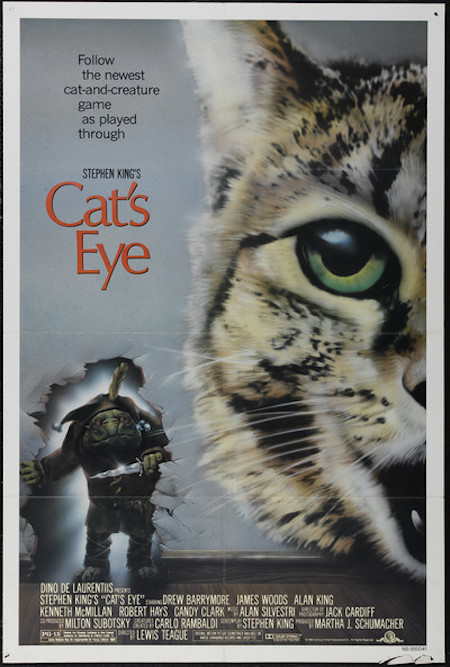
The culture is currently going through another wave of King adoration as those who were around for his output during his…more “exuberant” days in the ’80s are now making their own projects. Stranger Things has always worn its King influences proudly and loudly. In recent times there have been film adaptations by folks like Andy Muschietti and Mike Flanagan, and TV shows on Hulu and HBO. With all of his books, short stories, scripts, TV episodes, movie adaptations, e-books, side projects, and more—there’s a lot to sift through and some titles will always be overshadowed.
Released 35 years ago yesterday, CAT’S EYE is one of those oft-overlooked entries that, while it was prime fodder in syndication and video stores, remains generally ignored in favor of King’s other anthology work like CREEPSHOW, CREEPSHOW 2, or TALES FROM THE DARKSIDE.
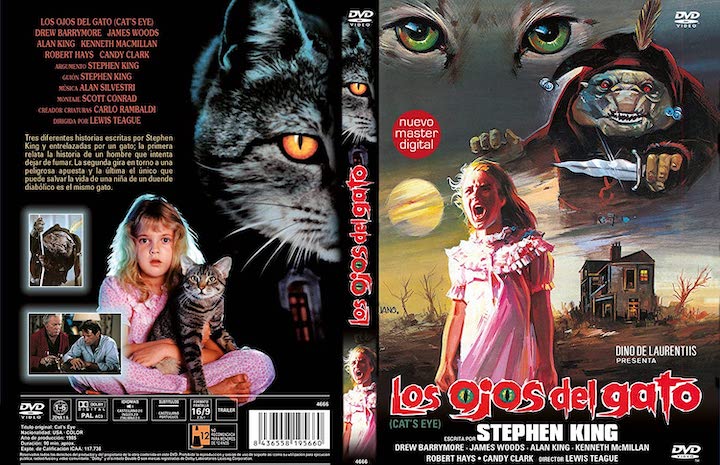
CAT’S EYE was financially successful, making almost twice its relatively low $7 million budget at the domestic box office. But the reviews were mixed at best, and mostly it’s remembered for one segment, a particular plot point, and the VHS box art with Drew Barrymore and her feline companion. And while CREEPSHOW, SOUTHBOUND, and a few other horror anthologies have stayed in the genre zeitgeist, most drift away only to be recalled for maybe one story (if that). This seems to be the case for CAT’S EYE as well—which is based on two previously published stories by King (“Quitters, Inc.” and “The Ledge”—both featured in his Night Shift collection) and a third segment that was specifically written for the screen.
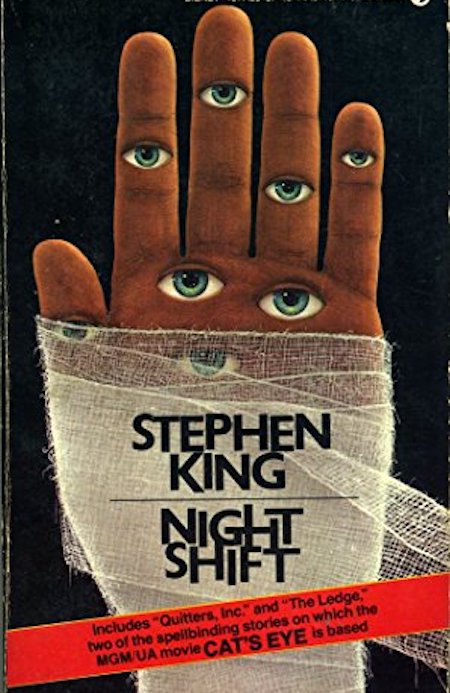
King wrote the script along with some help by CAT’S EYE‘s director, Lewis Teague (ALLIGATOR)—who had just worked on CUJO, though he never collaborated with the author during that production. CAT’S EYE is the third Stephen King film produced by infamous Hollywood executive Dino De Laurentiis (previously producing THE DEAD ZONE and FIRESTARTER); De Laurentiis would go on to produce three more King projects—SILVER BULLET, MAXIMUM OVERDRIVE, and Sometimes They Come Back.
https://www.youtube.com/watch?v=BvbxjHq8U7E
The movie was mostly shot in Wilmington, North Carolina (with a handful of exteriors/pick up shots in NYC and Atlantic City). Renowned British cinematographer (and lesser known director in his own right) Jack Cardiff (SCENT OF MYSTERY, THE FREAKMAKER) handled cinematography, while Carlo Rambaldi (E.T.’s designer) would create the creature effects, and Alan Silvestri contributed a mostly electronic synth score in one of his earlier jobs (which does sound conspicuously like his BACK TO THE FUTURE work at times—odd as he was composer for that movie after CAT’S EYE).
CAT’S EYE was supposed to start with a longer prologue that established why the cat (later named “General,” so let’s just call him that) ends up being drawn into battle with the evil force of the final segment. As Teague explains in his commentary for the King Of Horror Blu-ray collection, CAT’S EYE originally began with parents in Wilmington discovering their daughter (played by Drew Barrymore) is dead and are unaware that an evil troll killed her. Instead, the mother blames General, goes into the basement to retrieve a machine gun, and then shoots up her house trying to assassinate this innocent tabby. Teague concedes that the prologue was “a bit too silly” and that it is “probably best” it was cut.
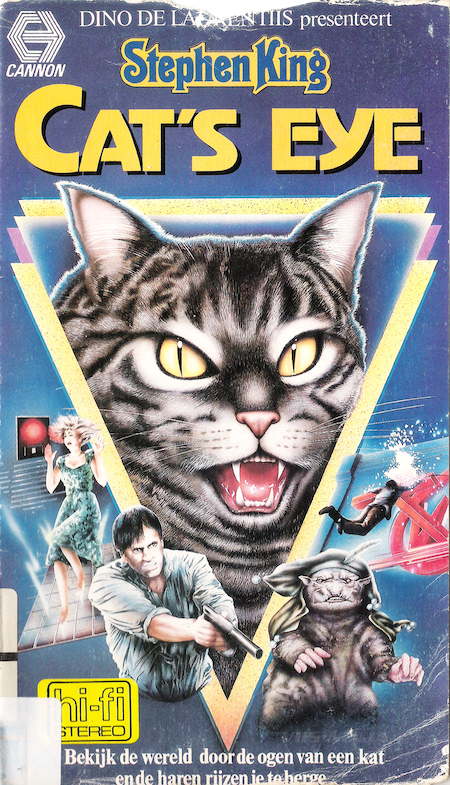
Instead, CAT’S EYE now opens with General being chased by Cujo (not officially named but looks exactly like the killer canine, and in fact was played by one of the Saint Bernards from Teague’s adaptation), almost being run over by Christine (complete with a bumper sticker that literally says “I Am Christine”) before hopping onto a truck that delivers General into the Big Apple.
Teague and King both wanted this to be a horror anthology with lots of humor. At one point James Woods is watching Cronenberg’s THE DEAD ZONE and in another segment Candy Clark is reading Pet Sematary. These are meant to be cute nods that suggest “hey, we’re all having fun here”—but it undercuts any sort of tension meant to propel the stories. Macabre humor works well in anthologies, as Amicus and more have shown in the past—but a constant change in tone, then it really dilutes a sense of menace.
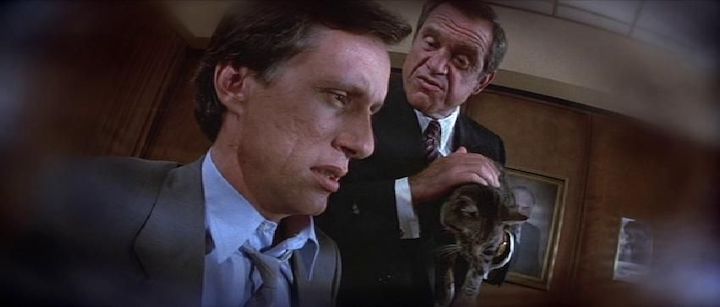
There’s also the matter of the segments themselves and how well they work individually and together. “Quitters, Inc.” follows James Woods who is trying to quit smoking and so he turns to the titular company to help him—ostensibly run by (possibly reformed mafioso?) Alan King. King informs Woods that he will be under constant surveillance, and if Woods smokes a cigarette they will torture his wife, beat up his developmentally challenged daughter (also played by Drew Barrymore), and the list goes on and on with each lapse resulting in a horrific consequence to the ones Woods loves.
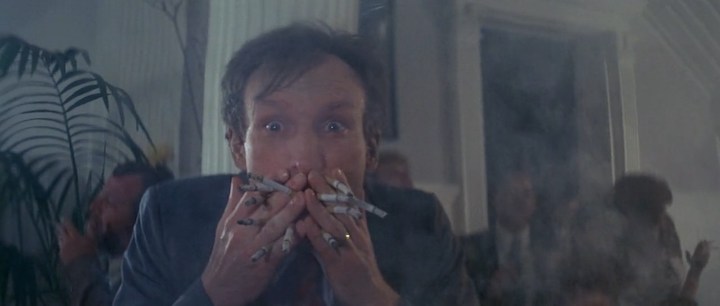
“Quitters, Inc.” has stayed with audiences because it’s one of those slightly elevated versions of reality that aren’t real but seems like people are demented enough to enact—like hunting humans for sport. It was slightly ahead of curve of the large societal push against smoking and could probably be read as a screed of taking choice away from individuals—but mostly it’s probably just a good insight into hard it is to kick a habit. There is a magnificent centerpiece sequence where Woods is hallucinating that everyone at a party he’s attending is smoking like a fiend (including children, an oil painting, beloved character actor James Rebhorn, and some women dressed up like giant packs of cigarettes).
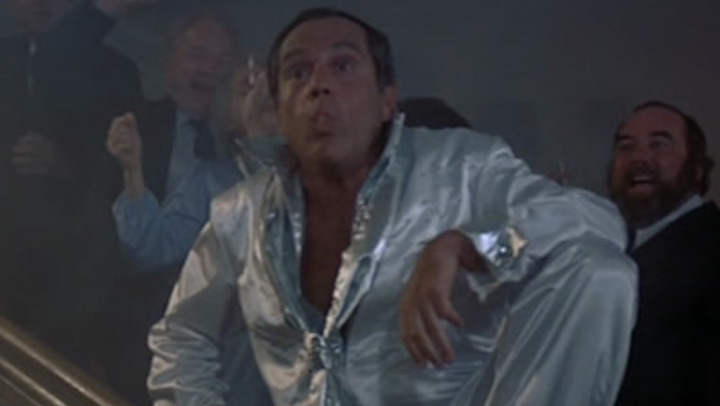
And then, as the pressure mounts—Alan King shows up in a lovely silver jumpsuit lip-synching The Police’s “Every Breath You Take.” That song gets repeated throughout CAT’S EYE, but there are also covers of “96 Tears” and “Twist n Shout.” It’s so very odd to practically see De Laurentiis’ accounting at work where he’ll buy the rights to the song but not the recording and basically believes it’s the same thing. I mean, it’s not like The Beatles have a signature sound, right?
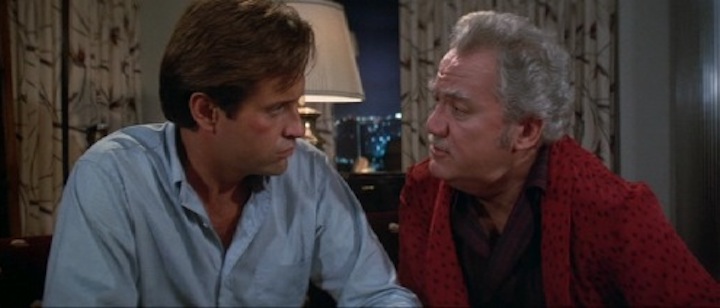
The middle section is “The Ledge” in which Robert Hays (AIRPLANE!) faces off against his romantic rival, Kenneth McMillan (DUNE, ARMED & DANGEROUS), in something out of E.C. Comics. Hays has been having an affair with McMillan’s wife—but McMillan is a sporting fellow so he bets Hays that if Hays can get around the ledge of McMillan’s top floor penthouse then “You get the girl, you get the gold watch, you get everything.” Of course, McMillan tries all sorts of ways to dislodge Hays—including a comedy horn, a firehose, and more—but to no avail as Hays makes his way back inside. However, being akin to the chilling tales found in The Witching Hour or The Vault Of Horror, it turns out McMillan already killed his wife so, like all dickish villains, he literally kept his word as he kicks the severed head of his bride over to Hays. Technically correct…the best kind of correct!
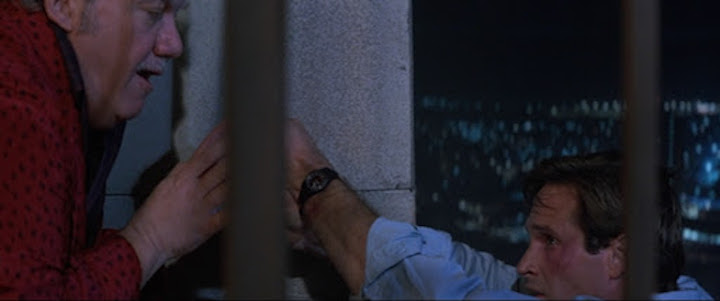
Hays dispenses of McMillan’s hired goons, and now it’s the high roller who has to take on the titular challenge. He does not do as well. This CAT’S EYE segment has a lot of promise and features some cool miniatures and matte paintings, but the main problem is one of balance. Teague has to make the task seem very arduous and require sustained effort and time to circumnnavigate the whole building—but it also can’t simply be a dude inching along on a small bit of concrete that’s not actually high up in the air for 20 minutes. That proves too hard to pull off and it ends up being a lot of stop and start. If done right, this story would be a great two-hander of the loathsome fat cat goading this everyman in a truly precarious situation.
You’ll probably have noticed that the titular cat of CAT’S EYE hasn’t been getting a lot of play in these recaps. General doesn’t really have much to do in either story—in the first he’s snatched to showcase a metal room rigged to shock James Woods’ wife should he smoke a cigarette, and in the latter McMillan decides the cat is good luck because it didn’t get run over by a car. In both cases, General makes a quick break for it before the conclusion of the story and encounters some odd apparition of Drew Barrymore telling the cat that the danger is “getting closer.”
CAT’S EYE was originally conceived by De Laurentiis as a vehicle for Barrymore as he knew she was going to be a big star based on working with her in FIRESTARTER—so perhaps it’s an attempt to give her more screen time by awkwardly shoehorning in to the aborted prologue, and as Woods’ daughter, and these prophetic visions.

The third and final segment finds cat and Barrymore united, and now he has a name—all to the chagrin of her mom (Candy Clark). Her dad (James Naughton) doesn’t really seem to care and if anything is pulling a real “good cop, bad cop”—not a great parenting style, fake dad! Turns out that Clark’s mom used to tell them all about how cats suck up kids’ breaths in their sleep and kill them. But luckily for them that all their attempts to get rid of (or literally kill) the cat are for naught, as it turns out there’s a troll in the walls of this house and it’s up to General to take the fight to the little monster as it tries to take the breath away from Barrymore.
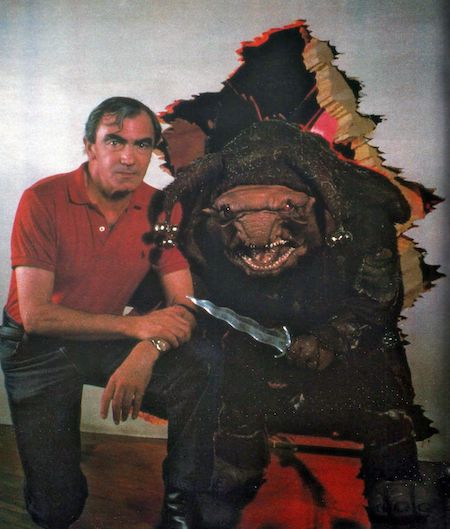
Cat meets Troll, Cat wins…Fatality. It’s a pretty funny sequence that plays very cartoonish: the cat plays an EP of the cover of “Every Breath You Take” at faster and faster speeds before the troll is flung off to its eternal reward when it crashes into, and gets rendered to pieces by, a nearby fan.
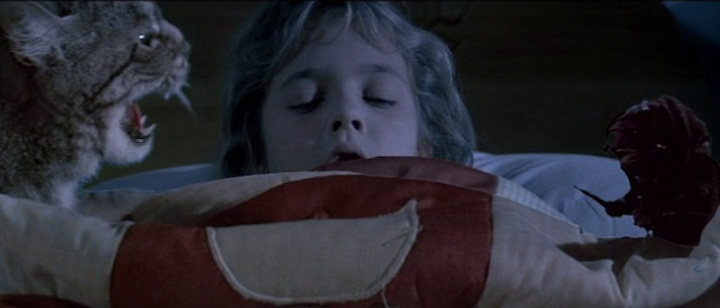
The parents come in, see a dismembered troll and they are surprised—but not so much that they leave the house, or call anybody, or do anything about it, except stop trying to expel and exterminate General. And so CAT’S EYE comes to a close.
Yes, the Stephen King anthology which was supposed to start with a child death and a hail of bullets, move on to torture of innocent family members, then torment and decapitation of a wife (how does this movie feel about women? hard to say), before a battle with a horrific monster results in mutilation of a mischievous imp…ends on a sweet freeze frame of a little girl grabbing some shut eye with her new feline friend. It’s an odd call.
Also an odd call? After three covers of popular songs, and some kind of uninspired Alan Silvestri score work, the credits kick off with the a licensed theme song for CAT’S EYE—titled “Cat’s Eye,” written and performed by Ray Stephens. It’s a great ’80s tune but is way more suited for a jazzercise class than a triptych of terror.
https://www.youtube.com/watch?v=zfvwmnClMCI
[Editor’s Note: The previous version of this post misidentified the song as belonging to Ray Stevens, the sonic wizard behind novelty hits “Gitarzan” and “The Streak.“] Ray Stephens was a singer and actor primarily known for appearing in The Great Space Coaster (as “Roy”) and for being the Cop in The Village People starting in 1985 for one album (Sex Over The Phone) and some touring. There is nothing that suggests the fabulosity of Stephens’ song in CAT’S EYE making it a very weird tonal capper for this…well, tonally weird movie. So, in that regard—it’s pretty apt, I guess.
Ultimately Teague’s film was financially successful, De Laurentiis kept working with King (and in Wilmington), Drew Barrymore was a big star, and people mostly remember CAT’S EYE due to “Quitters, Inc.” and the forced perspective troll monster at the end.
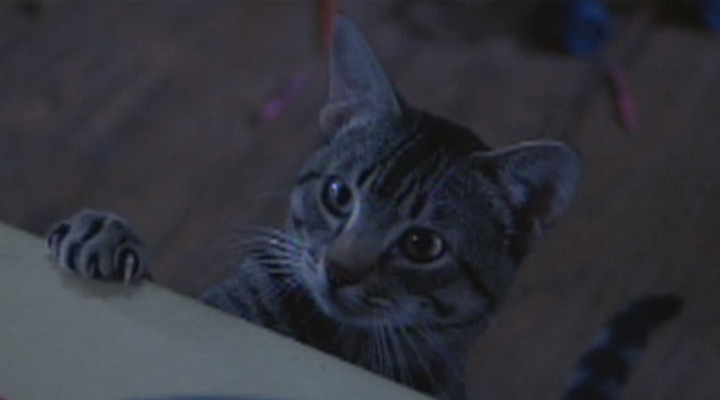
Quick side question: what is up with Stephen King and cats? They are the heroes of SLEEPWALKERS, one of them runs amuck on poor Jud Crandall in Pet Sematary, and there’s that segment in TALES FROM THE DARKSIDE: THE MOVIE where it burrows inside Buster Poindexter. My theory is that King genuinely respects these animals and thinks they are far more dangerous than most people believe, for good AND ill. Fearful symmetry, indeed.
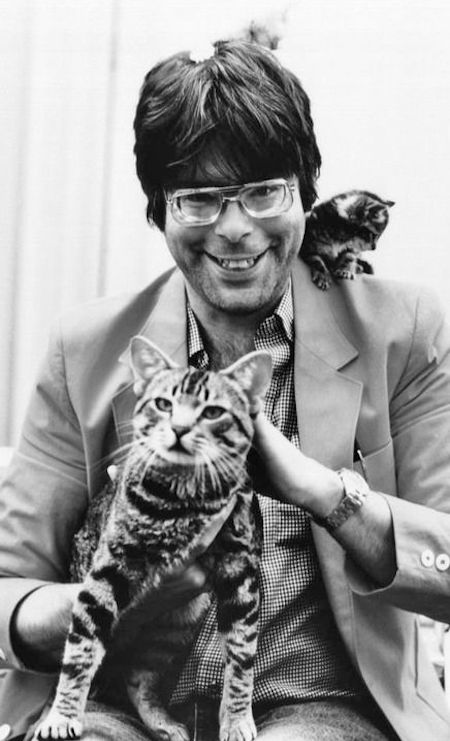
The best thing that came out of CAT’S EYE (assuming you’re not a MAXIMUM OVERDRIVE fan), though, remains the We Hate Movies podcast 2013 episode on it. Easily one of the funniest episodes of a podcast I’ve ever heard—it affords lots of tangents about Alan King never being able to grasp sci-fi/fantasy concepts, hot dogs made for cats, and more—seek it out as the episode is truly fantastic.
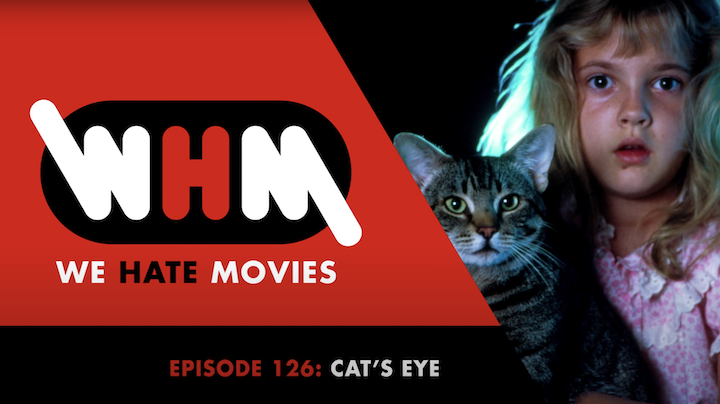
I watched CAT’S EYE a bunch as a kid on video, but it’s not with any nostalgia that I look back on it. It is a PG-13 Stephen King movie, so I was allowed to watch it as a kid; I love cats; and I have a real fondness for films that end with a sudden appearance of fairly well-executed monster (looking at you, HOWARD THE DUCK). Teague and King wanted to make a fun anthology with frights and laughs, and they kind of did—all while having very little budget and away from the studio system.
This shaky anthology is further proof of the omnipresence and endurance of the biggest name in the past 100 years in horror. There’s still gold in this bonkers movie and King kept on churning on better and better tales for years after CAT’S EYE. Sometimes, it’s good to be King.
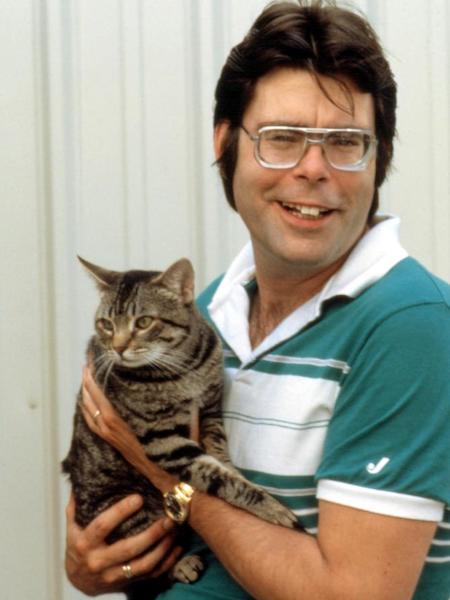
WAIT!
Are the apparitions of Drew Barrymore that General sees earlier in CAT’S EYE left over from the original opening? Like it’s supposed to be the ghost of the dead girl from the non-existent prologue? Or it’s just a psychic connection—but then why doesn’t Barrymore acknowledge it at all when General shows up at her house? I know I’m supposed to be wrapping this post up but I just…I have so many questions…Oy.
Take me away, Ray Stevens…
Tags: 1985, Alan King, Alan Silvestri, Anthologies, candy clark, Carlo Rambaldi, Dino De Laurentiis, Drew Barrymore, Frank Welker, Horror, Jack Cardiff, James Naughton, James Woods, Kenneth McMillan, Lewis Teague, Night Shift, North Carolina, Ray Stephens, Robert Hays, Sex Over The Phone, The Police, The Village People, We Hate Movies, Wilmington

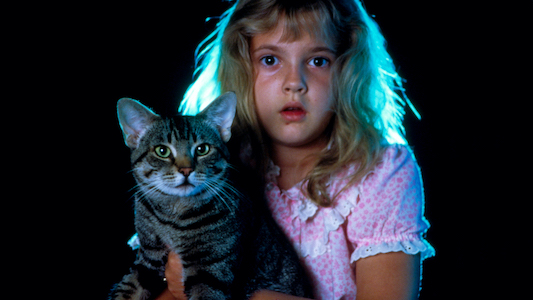
No Comments